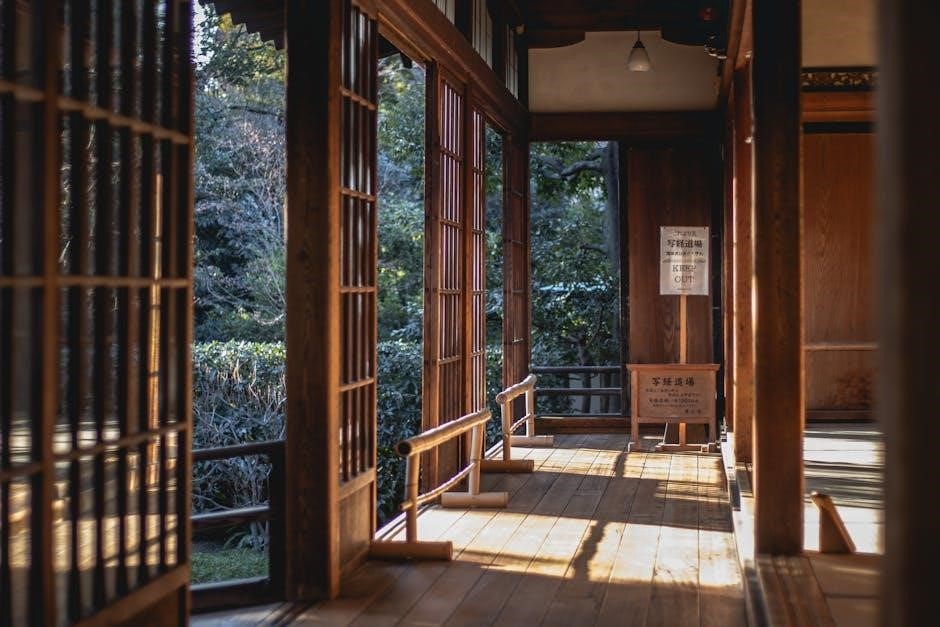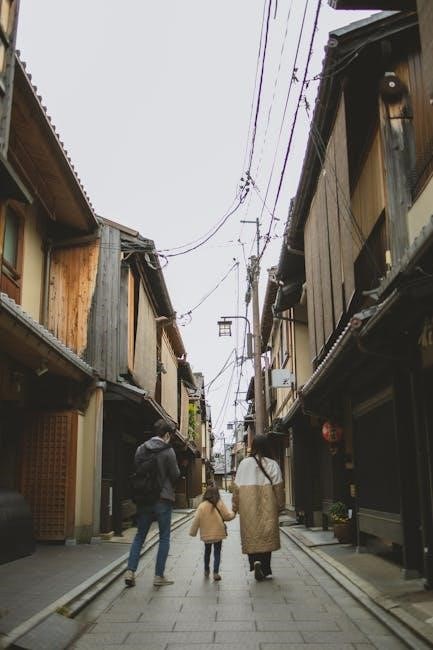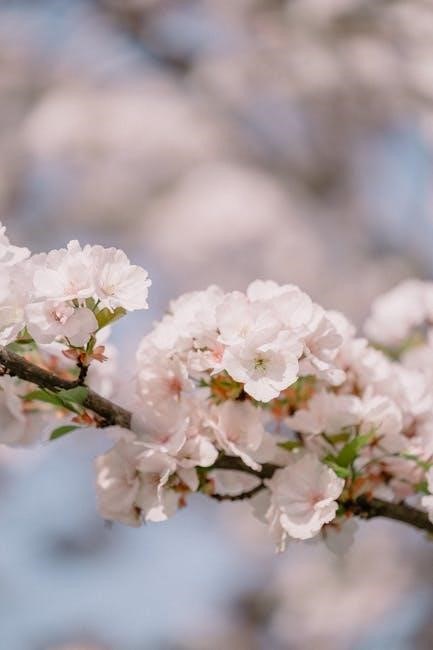The Shoyoen Japanese Gardens Self-Guided Walk offers a serene, picturesque environment designed to reflect Nikko’s natural beauty. This tranquil garden, a gift from Dubbo’s sister city Minokamo, provides an immersive cultural experience with its traditional Japanese design and interactive features like the Shoyoen Sound Walk app, enhancing visitor exploration and appreciation of its beauty.
Overview of the Garden
Shoyoen Japanese Gardens is a traditional Japanese garden designed to emulate the natural beauty of Nikko, featuring meticulously landscaped ponds, waterfalls, and stone arrangements. Located in Elizabeth Park, it was gifted to Dubbo by its sister city, Minokamo, reflecting deep cultural ties. The garden incorporates tiered designs for optimal views, blending nature with tranquility. Its serene atmosphere makes it a perfect retreat for visitors seeking relaxation and cultural immersion. Recognized as one of Australia’s most authentic Japanese gardens, Shoyoen offers a harmonious blend of traditional aesthetics and natural splendor, inviting guests to explore its beauty at their own pace.
Importance of Self-Guided Tours
Self-guided tours at Shoyoen Japanese Gardens provide visitors with the freedom to explore the serene landscapes at their own pace, fostering a deeper connection with the garden’s tranquility. This approach allows individuals to immerse themselves in the cultural and natural beauty of the garden without feeling rushed. The availability of interactive features, such as the Shoyoen Sound Walk app and QR codes, enhances the experience by offering insights into the garden’s history, design, and significance. This independent exploration encourages visitors to appreciate the intricate details and reflect on the garden’s cultural importance, making the experience both educational and personally enriching.

Location and Access
Shoyoen Japanese Gardens is located at 851 Coronation Drive, Dubbo, NSW 2830, within the Elizabeth Park Regional Botanic Gardens, offering easy access for visitors to enjoy.
Address and Directions
The Shoyoen Japanese Gardens Self-Guided Walk is located at 851 Coronation Drive, Dubbo, NSW 2830, within the Elizabeth Park Regional Botanic Gardens. Situated on Birch Avenue in East Dubbo, the gardens are easily accessible by car or public transport. Visitors can navigate via GPS using the provided address, with ample parking available on site. The garden’s serene location offers a peaceful retreat, surrounded by natural beauty and cultural significance. Directions are well-signposted, making it simple for visitors to find their way to this tranquil oasis. The gardens are also close to other attractions, making it a convenient stop for those exploring the region.
Opening Hours
The Shoyoen Japanese Gardens are open to visitors with specific hours to accommodate different days and occasions. On Monday to Friday, the gardens operate from 9:00 AM to 4:00 PM. During weekends, the hours extend slightly, running from 9:30 AM to 4:30 PM. On Anzac Day, the gardens are open from 12:00 PM to 4:00 PM. However, the gardens are closed on Christmas Day, New Year’s Day, and Good Friday. These hours ensure visitors can plan their self-guided walks accordingly, allowing ample time to explore the serene landscapes and cultural features. Please note that hours may vary on public holidays, so it’s wise to check before planning your visit.

Ticket Information
Tickets for the Shoyoen Japanese Gardens Self-Guided Walk are essential for entry, offering access to the serene landscapes and cultural features. General admission includes entry to the adjacent treasure house, enhancing the overall experience. Pricing may vary depending on the season or special events, so it’s recommended to contact the garden via phone for the most accurate information. Visitors can enjoy the self-guided tour at their own pace, immersing themselves in the tranquility of the garden. Payment options and discounts, if available, can be confirmed upon booking. This ensures a smooth and enjoyable visit to this picturesque Japanese garden in Dubbo.
Parking and Accessibility
The Shoyoen Japanese Gardens offers ample parking facilities, making it easily accessible for visitors. The garden is well-maintained, with pathways designed for a leisurely stroll. Accessibility features ensure that visitors of all mobility levels can enjoy the serene environment. The garden’s design incorporates tiered landscapes, providing great views and easy navigation. With plenty of parking available, visitors can conveniently explore the garden’s tranquility. The accessible pathways and well-maintained grounds make it an ideal destination for families, photographers, and nature enthusiasts alike. This ensures a pleasant and uninterrupted experience for everyone visiting the Shoyoen Japanese Gardens Self-Guided Walk.
Historical Background
Shoyoen Garden, established in 2002, is a gift from Dubbo’s sister city, Minokamo. It reflects traditional Japanese design and cultural heritage, part of Rinno-ji Temple, founded in 766.
Shoyoen Garden’s Sister City Connection
Shoyoen Japanese Garden was gifted to Dubbo by its sister city, Minokamo, in Japan. This cultural exchange symbolizes friendship and mutual respect. The garden, opened in November 2002, reflects the natural beauty of Nikko, with design elements inspired by Mt. Nantai and stones sourced from local mountains and rivers. It is part of the Rinno-ji Temple complex, founded in 766 by Shodo Shonin, a significant site for meditation and autumn foliage. The garden embodies traditional Japanese aesthetics, offering a serene environment that fosters cross-cultural understanding and appreciation. This connection highlights the enduring bond between Dubbo and Minokamo, celebrating shared heritage and natural beauty.

Design and Cultural Significance
Shoyoen Japanese Garden is a traditional Japanese Pond Garden, showcasing meticulous design principles that reflect Japan’s natural beauty and Zen philosophy. The garden incorporates elements like waterfalls, ponds, and strategically placed stones, symbolizing harmony with nature. Its design mirrors the landscapes of Nikko, particularly Mt. Nantai, creating a serene atmosphere. The garden is part of the Rinno-ji Temple complex, a historic site founded in 766 by Shodo Shonin, emphasizing its cultural and spiritual significance. The use of natural materials and symbolic arrangements highlights Japanese aesthetics, making it a authentic representation of traditional gardens. This design fosters contemplation and appreciation of Japanese cultural heritage.

The Self-Guided Tour Experience
Discover the serene beauty of Shoyoen Japanese Gardens through a self-guided walk, offering tranquility, cultural insights, and interactive features that enhance your journey through this meticulously designed landscape.
Key Features of the Garden
Shoyoen Japanese Gardens is a meticulously designed space reflecting traditional Japanese aesthetics, with natural beauty and cultural significance. The garden features a central pond surrounded by maple trees, offering stunning autumn colors.Stone pathways guide visitors through tiered landscapes, incorporating elements like the Aka Bashi bridge and a waterfall. The design draws inspiration from Nikko’s natural beauty, with stones sourced from local mountains and rivers. Serene seating areas and strategically placed ornaments enhance the tranquil ambiance. Interactive elements like QR codes and the Shoyoen Sound Walk app provide deeper insights into the garden’s history and design, enriching the visitor experience.

Step-by-Step Walking Guide
Begin your journey at the Entry Gate of Mystic Profundity, designed to reveal partial views, sparking curiosity. Proceed across the Aka Bashi bridge, offering views of the pond and surrounding maple trees. Follow the stone pathways to the waterfall, where the soothing sounds enhance the serene atmosphere. Explore the tiered landscapes, noting the strategically placed stones and ornaments. Use the Shoyoen Sound Walk app or QR codes for deeper insights into the garden’s history and design. Conclude your walk at the resting area, where you can reflect on the beauty and tranquility of the garden. This self-guided tour ensures a personalized and enriching experience.

Seasonal Highlights
Shoyoen Japanese Gardens offers breathtaking beauty throughout the year, with seasonal highlights that captivate visitors. Autumn is a standout, featuring vibrant maple trees that create stunning displays around the central pond, often illuminated during special evening events. Spring brings the delicate beauty of cherry blossoms and traditional tea ceremonies, while summer showcases lush greenery and blooming flowers. Winter transforms the garden into a serene, tranquil space with frosty landscapes. Each season provides unique photo opportunities and a chance to experience the garden’s evolving charm; The seasonal light-up events and cultural activities further enhance the visitor experience, making every time of year a special moment to explore Shoyoen.
Interactive Elements
The Shoyoen Sound Walk app offers a self-guided audio tour, while QR codes provide additional insights, enhancing the visitor’s interactive experience with technology.

Shoyoen Sound Walk App
The Shoyoen Sound Walk app, available on the izi.TRAVEL platform, offers an engaging self-guided audio experience. Developed by Kim V. Goldsmith and Dubbo Regional Council, with assistance from Sister City Officer Kylie Sutherland, this app provides step-by-step insights into the garden’s design, cultural significance, and natural beauty. Visitors can explore the garden at their own pace, uncovering hidden stories and meanings behind its features. The app enhances the immersive experience, allowing visitors to connect deeply with the garden’s serene atmosphere and historical background. It’s a modern way to appreciate the timeless elegance of Shoyoen Japanese Gardens.
QR Codes and Digital Enhancements
Shoyoen Japanese Gardens incorporates QR codes to enhance the self-guided tour experience. Strategically placed throughout the garden, these codes provide visitors with instant access to detailed information about specific features, historical context, and cultural insights. By scanning the codes, visitors can explore additional content, such as descriptions of key landmarks, videos, and stories behind the garden’s design. This digital enhancement complements the Shoyoen Sound Walk app, offering a layered and interactive way to engage with the garden. The integration of QR codes ensures that visitors can delve deeper into the garden’s beauty and significance at their own pace, creating a more immersive and educational experience.
Visitor Tips and Etiquette
Visit during weekdays for a tranquil experience. Bring a camera to capture stunning views. Wear comfortable shoes for walking. Respect garden rules and natural beauty. Enjoy the serene atmosphere.
Best Times to Visit
The Shoyoen Japanese Gardens are open year-round, offering unique beauty in every season. Spring and autumn are particularly popular for vibrant colours and mild weather. Visit during weekdays for a quieter experience, while weekends are ideal for family outings. Autumn foliage peaks in early November, making it a must-visit time for photography enthusiasts. Summer days are perfect for strolling through the gardens, while winter provides a serene, tranquil atmosphere. Plan your visit early in the morning or late afternoon to avoid crowds and enjoy the gardens’ peaceful ambiance. Seasonal highlights, such as the autumn light-up event, add extra charm to your self-guided tour.
Photo Opportunities
Shoyoen Japanese Gardens offers countless photo opportunities, with its serene landscapes and vibrant seasonal displays. The garden’s central pond, surrounded by maple trees, is a picturesque spot, especially during autumn when the foliage is at its peak. The Aka Bashii bridge and the waterfall are popular subjects, capturing the essence of traditional Japanese design. Seasonal blooms, such as cherry blossoms in spring and autumnal colors, provide ever-changing backdrops for memorable photos. Visitors can also snap shots of the garden’s intricate stonework and tiered landscaping. Early morning and late afternoon light enhance the beauty of the garden, making these ideal times for photography enthusiasts to capture its tranquility and natural charm.

Cultural and Educational Value
Shoyoen Japanese Gardens offers deep cultural insights into traditional Japanese design and history. The garden serves as an educational bridge, showcasing Japan’s heritage through its authentic landscaping and features.
Historical Relevance
The Shoyoen Japanese Gardens hold significant historical value as a symbol of cultural exchange between Dubbo and its sister city, Minokamo, Japan. Established in 2002, the garden reflects traditional Japanese design principles, inspired by the natural beauty of Nikko. It is part of the Rinno-ji Temple complex, founded in 766 by Shodo Shonin, and is renowned for its autumn foliage. The garden’s design incorporates elements like stone arrangements and water features, replicating authentic Japanese aesthetics. This serene space serves as a cultural and educational resource, preserving Japanese heritage while fostering cross-cultural understanding. Its historical relevance lies in its role as a lasting symbol of friendship and shared traditions between Australia and Japan.
Learning Opportunities
The Shoyoen Japanese Gardens offer rich learning opportunities, blending cultural education with interactive exploration. Visitors can explore traditional Japanese garden design, understanding elements like water features, stone arrangements, and seasonal plantings. The Shoyoen Sound Walk app provides audio guides in multiple languages, offering insights into the garden’s history and design. QR codes placed throughout the garden link to additional digital content, enhancing the educational experience. This self-guided approach allows visitors to learn about Japanese cultural traditions, the significance of sister city relationships, and the artistry behind the garden’s creation. The garden serves as an outdoor classroom, fostering appreciation for Japanese heritage and environmental design principles.
The Shoyoen Japanese Gardens offer a peaceful retreat, blending natural beauty with cultural richness, providing visitors with a unique and enriching self-guided experience.

Final Thoughts
The Shoyoen Japanese Gardens Self-Guided Walk is a must-visit destination for those seeking tranquility and cultural enrichment. With its meticulously designed landscapes and seasonal beauty, the garden offers a serene escape from the bustling world. The inclusion of interactive elements like the Shoyoen Sound Walk app enhances the experience, providing deeper insights into the garden’s history and design. Whether strolling through the vibrant maple trees in autumn or enjoying the peaceful pond, visitors are immersed in a traditional Japanese atmosphere. This self-guided journey is perfect for nature lovers, photographers, and anyone looking to connect with Japanese culture in a unique and unforgettable way.
Encouragement to Visit
Visitors are warmly encouraged to explore the Shoyoen Japanese Gardens Self-Guided Walk, a hidden gem in Dubbo offering a unique blend of natural beauty and cultural richness. The garden’s serene atmosphere, vibrant seasonal displays, and interactive features make it an ideal destination for families, photographers, and nature enthusiasts. With its well-maintained pathways, ample parking, and accessible design, the garden is easy to navigate and enjoy. The Shoyoen Sound Walk app adds an extra layer of engagement, allowing visitors to deepen their connection with the garden’s history and design. Plan your visit today and immerse yourself in the tranquility of this authentic Japanese garden in the heart of Australia.
